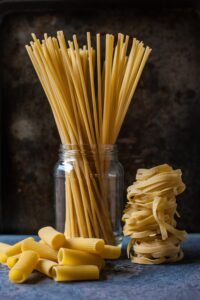How to Cook Perfect Al Dente Pasta Every Time
Does mastering the perfect al dente pasta feel like a never-ending science experiment? Sure, getting the water boiling and plopping your pasta in is the easy part. It’s the timing that throws you off, right? Well, you’re not alone.
Learning how to cook it correctly can be a bit tricky as it comes down to several factors, including the type of pasta and the timing in the pot. And, there’s a big difference when it comes to cooking dry or fresh pasta. So, if you haven’t quite figured out how to cook perfect al dente pasta, then fret not—we’re here to help.
What is Al Dente Pasta & How Long Do You Cook Pasta?
 The term “al dente” originates from an Italian phrase that translates to “to the tooth.” Al dente refers to the overall firmness of your cooked noodle. When your recipe calls for al dente pasta, it calls for your pasta to be tender yet still a bit firm in the center.
The term “al dente” originates from an Italian phrase that translates to “to the tooth.” Al dente refers to the overall firmness of your cooked noodle. When your recipe calls for al dente pasta, it calls for your pasta to be tender yet still a bit firm in the center.
When you’re trying to figure out the right timing for al dente pasta, note that there is a significant difference based on the type of pasta you’re using. You’ll find that dried pasta takes a bit more time, whereas freshly-made pasta only needs to be in the water for a couple of minutes—and the shape plays a role, too.
Elbow Macaroni
Elbow macaroni is a favorite, especially in families with children who love a classic macaroni and cheese recipe. Most dry boxes of pasta will include specific cooking instructions on the box for cooking al dente elbow macaroni. This particular pasta takes between 7-15 minutes to reach al dente—some brands may be larger than others, so adjust accordingly.
The easiest way to check if you’ve got it right is to take a bite of a single noodle. If it’s stiff and chalky in the center, then it’s likely undercooked. If it’s excessively soggy and limp instead, you’ve overcooked it.
Pasta Shells
Pasta shells are another tricky one when it comes to learning how to cook perfect al dente pasta. And, that’s because of the variety of unique shapes that these shells come in. While the outer edges of your shell may look done, the inner-most parts of the pasta may need some additional cook time. Generally, you want to cook pasta shells for 8-9 minutes to achieve the right firmness.
Fettuccine or Spaghetti
While fettuccine and spaghetti may seem similar, there are some key differences to consider when determining the proper cooking time. Fettuccine is a thicker, denser noodle, while spaghetti is smooth and round noodles. Spaghetti also comes in various sizes, such as thick and angel hair, affecting its cook time.
Once your water is boiling and you’ve placed your noodles into the pot, you’ll want to cook between 10-15 minutes. But, as always, make sure to give it a test before you start saucing up.
Pasta From Scratch
Now, cooking fresh pasta is a lot different. The primary factor is the fact that fresh pasta is already hydrated, whereas dry pasta rehydrates as it cooks. Freshly-made pasta only takes a few short minutes to cook thoroughly—2-3 minutes is enough to reach al dente.
Get Ready to Start Playing With All-New Recipes
Now that you know how to cook perfect al dente pasta, it’s time to put it into action. Give some new pasta recipes a try and see just how good your homemade pasta tastes! Want more fun takes on favorite foods and inspiring tips on cooking some of your favorite dishes? Make sure to check out our Spizzico blog for more!